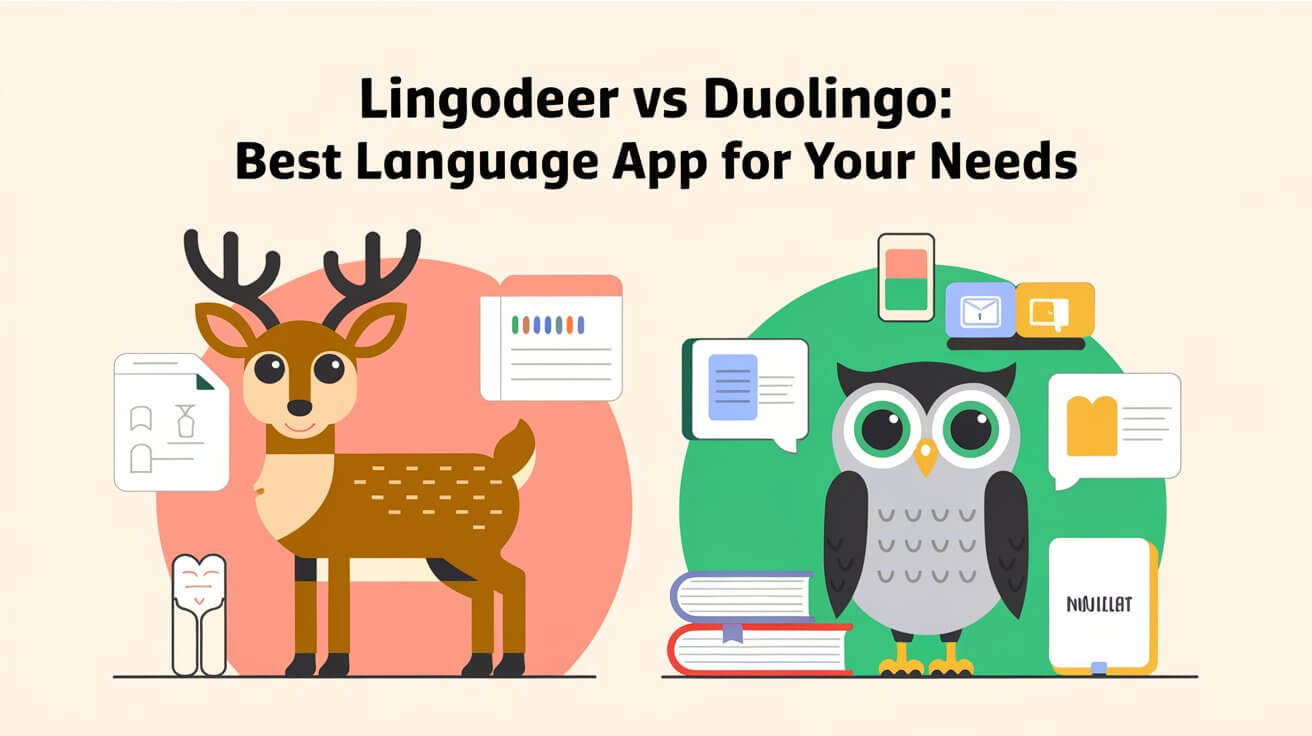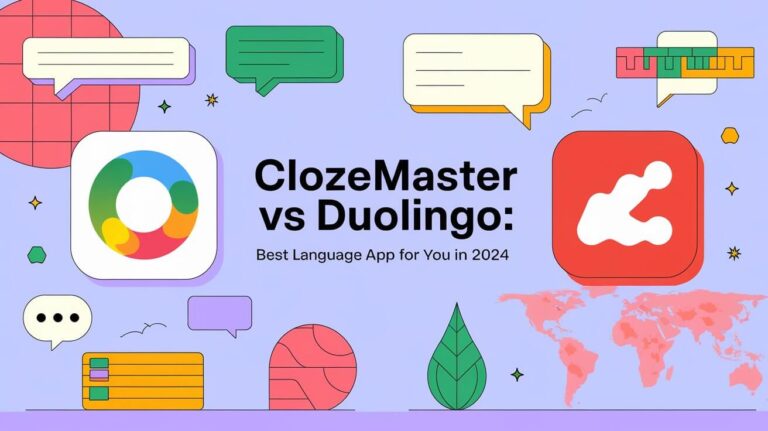Picking the right language app can boost your learning. LingoDeer and Duolingo are two top choices, but they’re not the same. This quick look at both apps will help you decide which fits your needs best. We’ll compare their key features so you can start your language journey on the right foot.
LingoDeer and Duolingo: A Quick Overview
Language learning apps have revolutionized how we approach foreign languages. LingoDeer and Duolingo are at the forefront of this revolution, each offering unique features and learning methods. Let’s dive into the world of these two language giants and see how they stack up against each other.
What is LingoDeer?
LingoDeer is a language learning app that focuses on Asian languages, though it has expanded to include European languages as well. It’s known for its structured approach and in-depth grammar explanations.
What is Duolingo?
Duolingo is a free language learning platform that uses gamification to make learning fun and engaging. It offers a wide range of languages and is popular for its bite-sized lessons and interactive exercises.
Language Options
Languages offered by LingoDeer
LingoDeer shines when it comes to Asian languages. It offers:
- Chinese
- Japanese
- Korean
- Vietnamese
But it doesn’t stop there. LingoDeer also covers:
- Spanish
- French
- German
- Portuguese
- Russian
- Italian
Languages available on Duolingo
Duolingo boasts an impressive array of languages:
- Spanish
- French
- German
- Italian
- Portuguese
- Russian
- Japanese
- Korean
- Chinese
- Arabic
- Hindi
- Turkish
- Dutch
- Swedish
- Greek
- and many more!
Duolingo even offers courses in fictional languages like Klingon and High Valyrian for the enthusiasts out there.
Learning Approach and Methodology
LingoDeer’s teaching style
LingoDeer takes a more traditional approach to language learning. It focuses on:
- Structured lessons
- Grammar explanations
- Vocabulary in context
- Cultural notes
This method is great for learners who want a solid foundation in grammar and sentence structure.
Duolingo’s gamified approach
Duolingo turns language learning into a game. Its features include:
- Skill trees
- Experience points
- Streaks and rewards
- Competitive leaderboards
This gamified approach keeps learners motivated and coming back for more.
Course Structure and Progression
How LingoDeer structures its lessons
LingoDeer’s courses are carefully crafted:
- Topics build on each other
- Grammar points are introduced systematically
- Vocabulary is themed and contextual
- Review sessions reinforce learning
Duolingo’s skill tree and lesson format
Duolingo uses a skill tree format:
- Skills are unlocked as you progress
- Lessons are short and varied
- Multiple choice, listening, and speaking exercises
- Regular skill strengthening prompts
Grammar Instruction
LingoDeer’s grammar explanations
LingoDeer excels in grammar instruction:
- Detailed explanations
- Examples in context
- Practice exercises focused on grammar points
- Tips and notes for each lesson
Grammar coverage in Duolingo
Duolingo’s approach to grammar is more implicit:
- Grammar is learned through exposure and practice
- Some explicit explanations in the Tips section
- Less focus on formal grammar rules
Vocabulary Building
LingoDeer’s vocabulary lessons
LingoDeer introduces vocabulary:
- In themed units
- With audio pronunciation
- Through various exercise types
- With spaced repetition for review
Duolingo’s vocabulary acquisition method
Duolingo builds vocabulary through:
- Repeated exposure in different contexts
- Image association
- Sentence translation
- Word banks and matching exercises
Speaking and Pronunciation Practice
LingoDeer’s speaking exercises
LingoDeer offers:
- Pronunciation guides
- Speaking practice with speech recognition
- Slow audio playback option
Duolingo’s pronunciation features
Duolingo includes:
- Speaking exercises throughout lessons
- Pronunciation tips
- Voice recording and playback
User Interface and Experience
Navigating the LingoDeer app
LingoDeer’s interface is:
- Clean and intuitive
- Easy to navigate
- Focused on learning without distractions
Duolingo’s app design and usability
Duolingo’s interface is:
- Colorful and engaging
- User-friendly with clear icons
- Designed to encourage daily use
Pricing and Plans
LingoDeer’s subscription options
LingoDeer offers:
- A free trial
- Monthly subscription ($15 )
- Yearly subscription (better value) ($80 )
- Lifetime access option ($160 )
Duolingo’s free version and premium features
Duolingo provides:
- A comprehensive free version
- Duolingo Plus subscription with additional features ($12.99 per month )
- Ad-free experience with Plus ($59.99 per month ) for one user
Community and Social Features
LingoDeer’s user community
LingoDeer has:
- A forum for discussions
- Social media presence
- Email support
Duolingo’s social elements and leaderboards
Duolingo emphasizes social learning:
- Friend lists and following
- Leaderboards and leagues
- Discussion forums for each skill
Effectiveness for Different Learning Goals
LingoDeer for serious language learners
LingoDeer is ideal for:
- Those wanting a strong grammar foundation
- Learners focusing on Asian languages
- Self-paced, structured learning
Duolingo for casual and motivated learners
Duolingo suits:
- Casual learners wanting bite-sized lessons
- Those motivated by gamification
- Learners wanting to try multiple languages
Strengths and Weaknesses
LingoDeer’s pros and cons
Pros:
- Excellent grammar explanations
- Well-structured courses
- Focus on Asian languages
Cons:
- Fewer language options
- Less gamification
- Paid subscription required for full access
Duolingo’s advantages and limitations
Pros:
- Free comprehensive courses
- Wide variety of languages
- Engaging gamified approach
Cons:
- Less in-depth grammar instruction
- Can feel repetitive
- Ads in free version
User Reviews and Feedback
What users say about LingoDeer
Users praise LingoDeer for:
- Clear explanations
- Effective teaching methods
- Quality of Asian language courses
Some users note:
- Limited language options
- Cost compared to free alternatives
Duolingo user experiences and opinions
Duolingo users appreciate:
- The free access to multiple languages
- Fun and engaging lessons
- Daily motivation through streaks and rewards
Criticisms include:
- Lack of in-depth explanations
- Sometimes unnatural sentences
- Repetitive exercises
Compatibility and Accessibility
LingoDeer’s platform availability
LingoDeer is available on:
- iOS devices
- Android devices
- Web browsers (beta)
Duolingo’s cross-platform support
Duolingo can be accessed on:
- iOS devices
- Android devices
- Web browsers
- Windows app
Updates and Improvements
Recent updates to LingoDeer
LingoDeer has recently:
- Added more European languages
- Improved speech recognition
- Enhanced review mechanisms
Duolingo’s latest features and changes
Duolingo has introduced:
- Stories for immersive learning
- Podcast for select languages
- Duolingo Events for in-person meetups
Choosing Between LingoDeer and Duolingo
Factors to consider
When deciding between LingoDeer and Duolingo, consider:
- Your target language
- Learning style preferences
- Budget constraints
- Time commitment
Which app suits different learning styles
Choose LingoDeer if you:
- Want structured, grammar-focused learning
- Are learning an Asian language
- Prefer a traditional approach
Opt for Duolingo if you:
- Enjoy gamified learning
- Want to try multiple languages
- Prefer free options with in-app purchases
Conclusion
Both LingoDeer and Duolingo offer valuable language learning experiences, each with its own strengths. LingoDeer excels in structured learning and grammar instruction, making it ideal for serious language learners, especially those focusing on Asian languages. Duolingo, with its gamified approach and wide language selection, is perfect for casual learners or those wanting to explore multiple languages.
The choice between LingoDeer and Duolingo depends on your learning style, goals, and target language. Try both apps. Many learners succeed by combining resources. Consistency is key in language learning, regardless of your choice.







